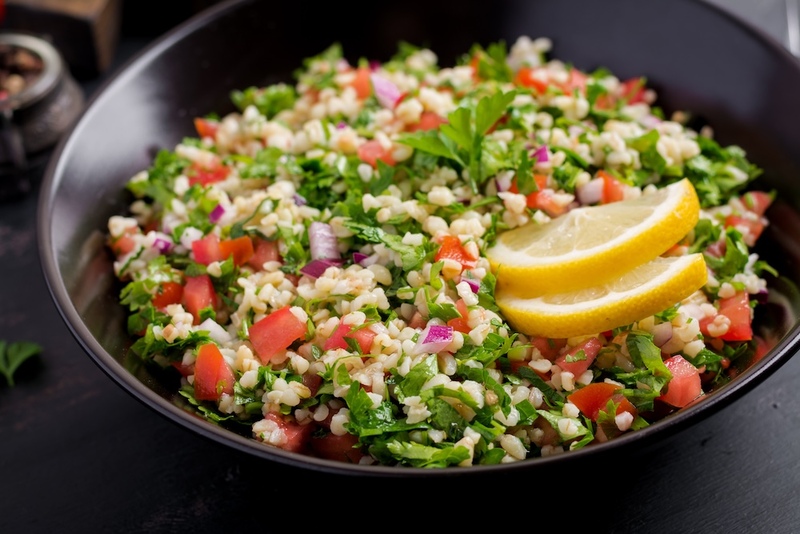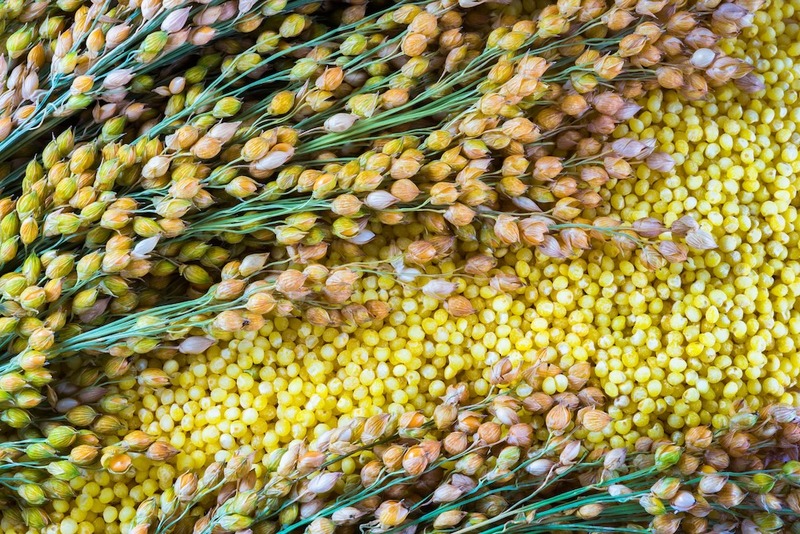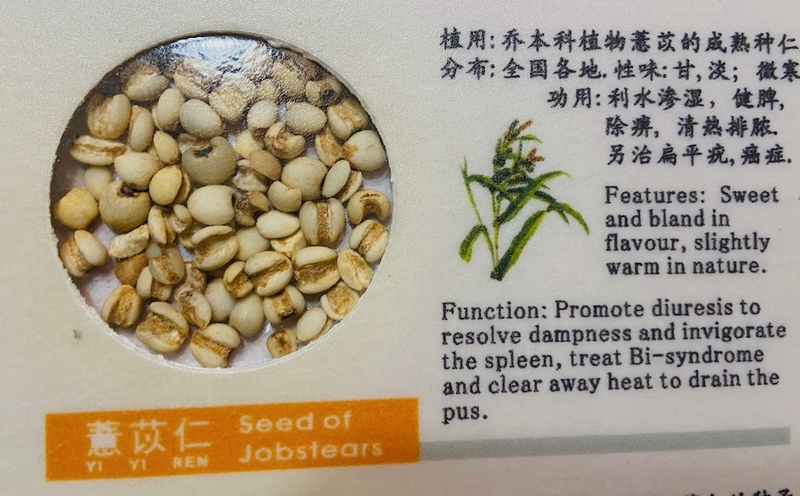
Like rice, millet is a hypoallergenic, gluten-free grain I like to use when trying to heal the gut and promote intestinal health. It is one of my favorite grains, being both very nutritious and one of the easiest grains to digest.
Surprisingly, I didn’t know that much about where millet comes from before I wrote this article. I’d assumed it came from one species in the grass family, but I was wrong. The seeds from many different genera and species of plants have been called millet. And, because the millet I buy from the grocery store doesn't list Latin names, I had no idea what specific variety I’ve been eating. It is helpful to differentiate the plants used to produce millet because the different types of millet vary in their uses and properties as health-promoting food or medicine.
Proso Millet (Panicum miliaceum)
 Proso millet, also known as common or white millet, is most likely the type of millet I've been getting from my local health food store. It is reported to have a slightly nutty flavor that I recognize. And while the seeds of this species can vary in color from creamy white or yellowish to orange, red, or brown, looking at pictures of proso millet seeds, they match what I have.
Proso millet, also known as common or white millet, is most likely the type of millet I've been getting from my local health food store. It is reported to have a slightly nutty flavor that I recognize. And while the seeds of this species can vary in color from creamy white or yellowish to orange, red, or brown, looking at pictures of proso millet seeds, they match what I have.
Proso millet is alkalizing, and other varieties may be alkalizing as well. This is unique because most grains are acidifying. It’s also easy to digest, which is what I experience when I eat millet. It is rich in protein, lecithin, B-complex vitamins, and minerals like phosphorus, calcium, zinc, and iron. It also has a low glycemic index, which makes it a good alternative to other grains if you want to manage your blood sugar and lose weight.
It can be cooked and eaten like rice, using two cups of water per cup of proso millet. I like to eat it as a breakfast cereal, like oatmeal or corn grits. If you soak the millet in water overnight, it makes it easier to digest and helps it cook faster. (The same is true for cooking oats or grits.)
 I also like to use millet to make tabbouleh, a parsley salad from the Middle East. It is made with parsley, onion, and mint with salt and a dressing of fresh lemon juice and olive oil. I also like to add tomatoes or cucumbers. While it is usually made with bulgar wheat, I make it with millet instead. I enjoy the nutty flavor the millet brings and find it makes the salad easier to digest and healthier for your intestines. You can find many recipes for tabbouleh salad online; just replace the wheat with equal parts millet.
I also like to use millet to make tabbouleh, a parsley salad from the Middle East. It is made with parsley, onion, and mint with salt and a dressing of fresh lemon juice and olive oil. I also like to add tomatoes or cucumbers. While it is usually made with bulgar wheat, I make it with millet instead. I enjoy the nutty flavor the millet brings and find it makes the salad easier to digest and healthier for your intestines. You can find many recipes for tabbouleh salad online; just replace the wheat with equal parts millet.
Pearl Millet (Cenchrus americanus syn Pennisetum glaucum)
 The most widely planted species is pearl millet. Pearl millet can be pale yellow, brown, grey, slate blue, white, or purple, and also has a subtle nutty flavor.
The most widely planted species is pearl millet. Pearl millet can be pale yellow, brown, grey, slate blue, white, or purple, and also has a subtle nutty flavor.
Like other species of millet, it’s a good protein source and is high in calcium, potassium, and magnesium. This variety also has an iron content that is eight times higher than rice. Like proso millet, it also has a low glycemic index. It is also a galactagogue, a remedy used to promote lactation in nursing mothers. It’s also fed to cows to help increase milk production.
Foxtail Millet (Setaria italica)
This variety of millet has a mild taste, so it’s a good variety to use as an alternative to rice. It’s the second most widely cultivated species and ranges in color from pale yellow to orange, red, brown, or black. Like the other millets, it is high in calcium and iron and has a low glycemic index.
Job’s Tears (Coix lacryma-jobi)
 Like the species above, Job’s tears or adlay millet can be eaten like rice. However, this species is also used in traditional Chinese medicine as a tonic for the stomach, spleen, and lungs. It is sweet, bland, and cool, relieves edema and water retention. It also reduces inflammation and helps with diarrhea caused by spleen deficiency. It is also used when there is blood or pus in the stools and may be useful for inflammatory bowel disorders when combined with other herbs. It is also used for abscesses in the lung or bowel and in the treatment of acne. I'd be curious to know how many of the intestinal healing qualities of Job’s tears may apply to other plants known as millet.
Like the species above, Job’s tears or adlay millet can be eaten like rice. However, this species is also used in traditional Chinese medicine as a tonic for the stomach, spleen, and lungs. It is sweet, bland, and cool, relieves edema and water retention. It also reduces inflammation and helps with diarrhea caused by spleen deficiency. It is also used when there is blood or pus in the stools and may be useful for inflammatory bowel disorders when combined with other herbs. It is also used for abscesses in the lung or bowel and in the treatment of acne. I'd be curious to know how many of the intestinal healing qualities of Job’s tears may apply to other plants known as millet.
Job’s tears isn't used as a single remedy in TCM; in nearly all of its applications, it is combined with other herbs. As an interesting side note, Job’s tears are used as beads to make Buddhist prayer beads and rosaries in some countries. They are named for the tears of Job, whose legendary sufferings are mentioned in the Bible.
Other Species Called Millet
 Sorghum (Sorghum bicolor) has also been called great millet. While it can be eaten like other forms of millet, it is mostly used for animal forage, production of a sweet syrup, and as a base for making ethanol. It is also the fifth most important cereal crop in the world, after rice, wheat, corn, and barley.
Sorghum (Sorghum bicolor) has also been called great millet. While it can be eaten like other forms of millet, it is mostly used for animal forage, production of a sweet syrup, and as a base for making ethanol. It is also the fifth most important cereal crop in the world, after rice, wheat, corn, and barley.
Teff (Eragrostis tef) is a grain from Ethiopia that’s making inroads into the health food market in the United States. Like the above-mentioned millets, it is very nutritious and gluten-free.
Other millet varieties around the world include finger millet (Eleusine coracana), Polish millet (Digitaria sanguinalis), raishan (Digitaria compacta), and a few others. If you want to learn more about millets, read the article Types of Millets.
While we’re unlikely to see most of these offered commercially in the United States, I have a whole new appreciation of millet after researching this article. Not only are millets nutritious, gluten-free, and hypoallergenic, they are also drought-tolerant and grow fairly quickly, making them valuable crops in places where other grains might not grow.
If you haven’t tried millet yet, I encourage you to do so. It’s a tasty alternative to rice as a grain for people on gluten-free diets. And, it can also be ground into flour and used in a variety of baked goods.
Steven's Articles
October
-

-
Understanding Caffeine & Cellular Adaptation
Preserving the power of caffeine's buzz and the…
September
-

-
Horseradish
A pungent spice for aiding protein metabolism…
-

-
Banaba or Crepe Myrtle
A beautiful tree from Southeast Asia whose leaves…
August
-

-
Monkeyflowers
Flower essences to help see ourselves more clearly…
-

-
Mariposa Lilies
Strengthening the bond between mother and child…
-

-
The Noble Bay Leaf
A common kitchen herb for aiding digestion and…
-

-
Epimedium: Horny Goat Weed
A circulatory stimulant and kidney yang tonic…
July
-

-
The Medicinal and Nutritional Benefits of Apricots
A nutritious fruit and valuable medicinal seed for coughs
-

-
Dogwoods
Asian dogwood is used to stop excessive discharge,…
June
-

-
Neem: The Village Pharmacy
A popular Ayurvedic remedy for dental and immune…
-

-
Spilanthes: The Toothache Plant
A traditional remedy for teeth and gums, as well…
-

-
Forsythia
An anti-inflammatory, fever-reducing, and infection fighting herb
May
-

-
Buckwheat (Kashi)
A delicious, high protein, gluten-free, gut-healthy food
-

-
Leaky Gut Syndrome
Plugging the leaks on the underlying cause of…
-

-
Storksbill
An edible, medicinal, weedy herb, helpful for…

